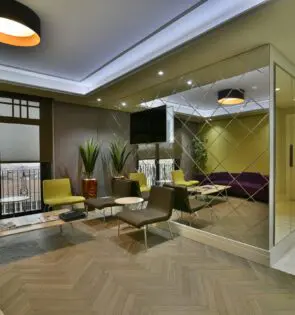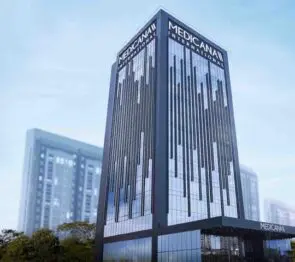Secondary Rhinoplasty: When Is It Worth Redoing Your Nose?
Rhinoplasty: When Is It Time for a Revision?

Rhinoplasty is a surgical procedure aimed at altering the shape and structure of the nose. It can be performed for both aesthetic and medical reasons. Modern rhinoplasty techniques allow for the improvement of facial appearance, correction of congenital defects, and restoration of the nose after injuries.
Indications for Rhinoplasty
Rhinoplasty is typically performed in the following cases:
-
Aesthetic improvements (modifying shape, size, correcting a hump or asymmetry);
-
Nasal reconstruction after trauma or accidents;
-
Correction of congenital abnormalities such as a deviated septum;
-
Improvement of breathing function if the nasal septum obstructs normal airflow.
Contraindications for Rhinoplasty
Despite its popularity, rhinoplasty is not suitable for everyone. Contraindications include:
-
Acute infections and inflammatory conditions;
-
Cancerous diseases;
-
Blood clotting disorders;
-
Severe chronic illnesses (e.g., advanced diabetes);
-
Psychological unpreparedness for changes in appearance.
Types of Rhinoplasty
There are several types of rhinoplasty procedures:
-
Open Rhinoplasty – an incision is made on the columella (the tissue between the nostrils), providing full access to nasal structures.
-
Closed Rhinoplasty – all incisions are made inside the nose, making the procedure less invasive and shortening the recovery time.
-
Reconstructive Rhinoplasty – used to rebuild the nose after trauma or tumor removal.
-
Revision (Secondary) Rhinoplasty – performed after a primary surgery if the patient is dissatisfied with the result or complications have arisen.
Why Is Revision Rhinoplasty Needed?
Secondary rhinoplasty may be necessary for a variety of reasons, most often due to insufficient or unpredictable results after the first procedure. The main causes include:
Insufficient or Excessive Correction
Sometimes the desired shape is not achieved during the first surgery, or an overly aggressive correction leads to an unnatural look. In such cases, patients may seek a revision to achieve a more balanced and natural appearance.
Postoperative Deformation or Tissue Changes
Healing tissues may shift or scar, resulting in asymmetry or deformity. This is especially common after complex surgeries or improper healing processes.
Breathing Difficulties
In some cases, changes in nasal structure after the surgery may cause airway obstruction or chronic inflammation. Revision rhinoplasty helps restore normal breathing and overall nasal function.
Dissatisfaction with Aesthetic Results
Even if the procedure was technically successful, the outcome might not match the patient’s expectations or facial proportions. A secondary procedure allows for fine-tuning.
Unpredictable Healing Outcomes
Scar formation, tissue thickening, or other unexpected changes during recovery may lead to a less desirable appearance or discomfort, requiring surgical correction.
Why Cartilage or Nasal Deformation May Occur After Primary Rhinoplasty
Changes in nasal shape after the first rhinoplasty may result from the healing process. Main causes include:
-
Improper healing: Tissues and cartilage need time to recover, and sometimes they shift or collapse during healing.
-
Overcorrection: Aggressive reshaping during surgery can weaken the nasal structure.
-
Cartilage instability: Removal or excessive reduction of cartilage during surgery can lead to poor support and shape loss.
-
Inadequate post-op care: Ignoring the surgeon’s advice, applying pressure to the nose, or trauma can cause deformities.
-
Elasticity of tissues: Some patients naturally have softer or more elastic tissues, which can affect the final result.
-
Genetic or anatomical factors: Personal healing tendencies or preexisting conditions can influence recovery.
-
Medical complications: Infections or tissue necrosis can affect the outcome and shape of the nose.
These risks can be minimized with proper surgical planning, an experienced surgeon, and diligent post-operative care.
Revision Rhinoplasty: Not a Failure, But a Step Toward Improvement
Revision rhinoplasty is not a punishment or a sign of failure—it’s a step toward a better quality of life. It helps patients achieve the results they initially hoped for. This procedure is often necessary for those who face difficulties with nasal shape or function after the first operation. It’s important to understand that revision surgeries are about refinement and enhancement, not fixing major failures.
When Should You Consider a Second Rhinoplasty?
Revision rhinoplasty is never done immediately after the first procedure. Time must be allowed for healing and evaluation. So, when is the right moment?
After Complete Healing
It’s recommended to wait at least 12 months after the initial surgery. The nose continues to change gradually, and only after full healing can the final result be evaluated properly.
If You Want to Enhance the Outcome
The goal isn’t just aesthetic perfection, but also internal comfort. Even minor changes can significantly boost confidence and improve self-perception. Revision rhinoplasty allows for a more harmonious and satisfying appearance.
In Case of Functional Issues
If breathing becomes difficult or nasal function is compromised after the first operation, a secondary procedure can restore normal functionality. Health must always come first.
When Minor Shape Changes Occur
Sometimes, subtle changes or small irregularities appear during healing. These can usually be corrected without a major procedure, improving the appearance with minimal intervention.
Important: Revision rhinoplasty is not a disaster or a mistake—it’s part of the journey to improvement. It’s meant to help you feel even more satisfied with your look and to bring your face closer to what you envisioned.
How Long Do Results Last?
Revision rhinoplasty is complex, and should only be performed for well-defined medical or aesthetic reasons. Each additional surgery is more complicated than the last, with a higher risk of complications.
However, just like the first procedure, the results of revision rhinoplasty are long-lasting. This is not a temporary fix—it brings lasting improvements to both appearance and function. The final shape of the nose forms gradually over 12–18 months, during which tissues settle and adapt.
Recovery after revision surgery is often slower due to prior interventions, but once healing is complete, the outcome is stable and durable. The nose becomes strong, functional, and aesthetically refined.
By following your surgeon’s instructions, attending follow-up appointments, and caring for your nose properly, you can preserve the results for many years.
✅ If you have clear reasons for a second procedure, choosing an experienced surgeon and preparing thoroughly are key. A consultation with the specialists at Globalmedik will help you make the right decision and achieve the result you truly want!








